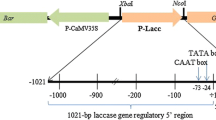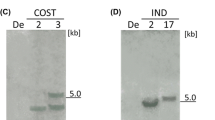Abstract
Patatin is a family of glycoproteins that contributes about 40% of the total soluble protein in tubers of potato (Solanum tuberosum L.). The protein is encoded by a multigene family of 50–70 genes which have been divided into classes I and II on the basis of sequence homology. The promoters of two class I genes, PS20 and PS3/27, were transcriptionally fused to β-glucuronidase and transformed into the potato cultivars Désirée and Maris Bard. Examination of the expression levels in large populations of microtubers indicated that the PS20 promoter produced β-glucuronidase activities 5-fold lower in Désirée than Maris Bard whereas the PS3/27 promoter showed similar levels in both cultivars. Furthermore, the relative expression levels from the two promoters were reversed in the two cultivars. The β-glucuronidase enzyme activity was correlated with the mRNA level but not the copy number of the introduced gene. The implications for the use of patatin promoters in the genetic modification of tubers is discussed.
Similar content being viewed by others
References
BeachyRN, ChenZL, HorschRB, RogersSG, HoffmanNJ, FraleyRT: Accumulation and assembly of soybean β-conglycinin in seeds of transformed petunia plants. EMBO J 4: 3047–3053 (1985).
BevanM, BarkerR, GoldsbroughA, JarvisM, KavanaghT, IturriagaG: The structure and transcription start site of a major potato tuber protein gene. Nucleic Acids Res 14: 4625–4638 (1986).
BroglieR, CoruzziG, FraleyRT, RogersSG, HorschRB, NiedermeyerJG, FinkCL, FlickJS, ChuaNH: Light regulated expression of a pea ribulose-1,5-bisphosphate carboxylase small subunit gene in transformed plant cells. Science 224: 838–843 (1984).
DeanC, van denElzenP, TamakiS, DunsmuirP, BedbrookJ: Differential expression of the eight genes of petunia ribulose bisphosphate carboxylase small subunit multi-gene family. EMBO J 4: 3055–3061 (1985).
DeanC, JonesJ, FavreauM, DunsmuirP, BedbrookJ: Influence of flanking sequences on variability in expression levels of an introduced gene in transgenic tobacco plants. Nucleic Acids Res 16: 9267–9283 (1988).
DeanC, FavreauM, Bond-NutterD, BedbrookJ, DunsmuirP: Sequences downstream of translation start regulate quantitative expression of two petunia rbcs genes. Plant Cell 1: 201–208 (1989).
DeanC, FavreauM, BedbrookJ, DunsmuirP: Sequences 5′ to translation start regulate expression of petunia rbcs genes. Plant Cell 1: 209–215 (1989).
DellaportaSL, WoodJ, HicksJB: A plant DNA minipreparation: version II. Plant Mol Biol Rep 1: 19–21 (1983).
DoverGA, FlavellRB: Molecular coevolution: DNA divergence and the maintenance of function. Cell 38: 622–623 (1984).
EckesP, RosahlS, SchellJ, WillmitzerL: Isolation and characterisation of a light-inducible, organ-specific gene from potato and analysis of its expression after tagging and transfer into tobacco and potato shoots. Mol Gen Genet 205: 14–22 (1986).
FeinbergA, VogelsteinB: A technique for radiolabelling DNA restriction endonuclease fragments to high specific activity. Anal Biochem 132: 6–13 (1983).
JeffersonR, KavanaghTA, BevanM: GUS fusions: β-glucuronidase as a sensitive and versatile gene fusion marker in higher plants. EMBO J 6: 3901–3907 (1987).
JohnsonDA, GautschJW, SportsmanJR, ElderJH: Improved technique utilising nonfat dry milk for analysis of proteins and nucleic acids transferred to nitrocellulose. Gene Anal Techn 1: 3–8 (1984).
JonesJ, DunsmuirP, BedbrookJ: High level expression of introduced chimaeric genes in regenerated transformed plants. EMBO J 4: 2411–2418 (1985).
JonesJ, GilbertD, GrayK, JorgensenR: T-DNA structure and gene expression in petunia plants transformed by Agrobacterium tumefaciens C58 derivatives. Mol Gen Genet 207: 478–485 (1987).
JorgensenJ, SnyderC, JonesJ: T-DNA is organised predominantly in inverted repeat structures in plants transformed with Agrobacterium tumefaciens C58 derivatives. Mol Gen Genet 207: 471–477 (1987).
KhandjianEW: Optimised hybridisation of DNA blotted and fixed to nitrocellulose and nylon membranes. Bio/technology 5: 165–167 (1987).
LogemannJ, SchellJ, WillmitzerL: Improved method for the isolation of RNA from plant tissues. Anal Biochem 163: 21–26 (1987).
ManiatisT, FritschE, SambrookJ: Molecular Cloning: A Laboratory Manual. Cold Spring Harbor Press, Cold Spring Harbor, NY (1982).
MiesfeldR, ArnheimM: Species specific rDNA transcription is due to promoter-specific binding factors. Molec Cell Biol 4: 221–227 (1984).
MigneryCA, PikaardCS, ParkWD: Molecular characterisation of the patatin multigene family of potato. Gene 42: 27–44 (1988).
MurashigeT, SkoogF: A revised medium for rapid growth and bioassays with tobacco tissue cultures. Physiol Plant 15: 473–497 (1962).
ParkWD, BlackwoodC, MigneryGA, HermodsonMA, ListerRM: Analysis of the heterogeneity of the 40 000 molecular weight tuber glycoprotein of potatoes by immunological methods and by NH2-terminal sequence analysis. Plant Physiol 71: 156–160 (1983).
PikaardCS, BruscaJS, HannapelDJ, ParkWD: The two classes of genes for the major potato tuber protein, patatin, are differentially expressed in tubers and roots. Nucleic Acids Res 15: 1979–1994 (1987).
RacusenD, FooteM: A major soluble glycoprotein of potato. J Food Biochem 4: 43–52 (1980).
Rocha-SosaM, SonnewaldU, FrommerW, StratmannM, SchellJ, WillmitzerL: Both developmental and metabolic signals activate the promoter of a class I patatin gene. EMBO J 8: 23–29 (1989).
RosahlS, SchmidtR, SchellJ, WillmitzerL: Isolation and characterisation of a gene from Solanum tuberosum encoding patatin, the major storage protein of potato tubers. Mol Gen Genet 203: 214–220 (1986).
TwellD, OomsG: The 5′ flanking DNA of a patatin gene directs tuber specific expression of a chimaeric gene in potato. Plant Mol Biol 9: 345–375 (1987).
Twell D: Molecular analysis of the patatin gene family of potato (Solanum tuberosum L.). PhD Thesis University of London (1988).
TwellD, OomsG: Structural diversity of the patatin gene family in potato cv. Désirée. Mol Gen Genet 212: 325–336 (1988).
WenzlerHC, MigneryGA, FisherLM, ParkWD: Analysis of a chimaeric class-I patatin-GUS gene in transgenic potato plants: High-level expression in tubers and sucrose-inducible expression in cultured leaf and stem explants. Plant Mol Biol 12: 41–50 (1989).
Author information
Authors and Affiliations
Rights and permissions
About this article
Cite this article
Blundy, K.S., Blundy, M.A.C., Carter, D. et al. The expression of class I patatin gene fusions in transgenic potato varies with both gene and cultivar. Plant Mol Biol 16, 153–160 (1991). https://doi.org/10.1007/BF00017925
Received:
Accepted:
Issue Date:
DOI: https://doi.org/10.1007/BF00017925




